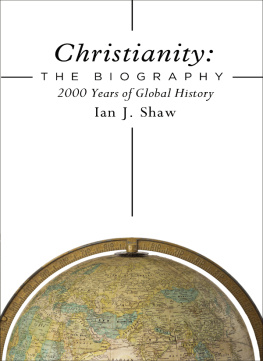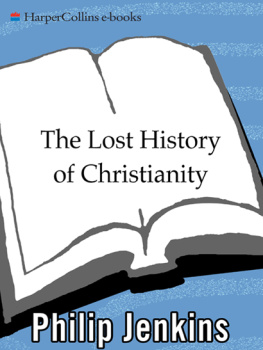The First Thousand Years
The First Thousand Years
A GLOBAL HISTORY OF CHRISTIANITY
ROBERT LOUIS WILKEN
Yale
UNIVERSITY
PRESS
New Haven and London
Copyright 2012 by Robert Louis Wilken. All rights reserved. This book may not be reproduced, in whole or in part, including illustrations, in any form (beyond that copying permitted by Sections 107 and 108 of the U.S. Copyright Law and except by reviewers for the public press), without written permission from the publishers.
Yale University Press books may be purchased in quantity for educational, business, or promotional use. For information, please e-mail sales.press@yale. edu (U.S. office) or sales@yaleup.co.uk (U.K. office).
Designed by Nancy Ovedovitz and set in Galliard Oldstyle type by Keystone Typesetting, Inc. Printed in the United States of America.
Library of Congress Cataloging-in-Publication Data
Wilken, Robert Louis, 1936
The first thousand years : a global history of Christianity / Robert Louis Wilken.
p. cm.
Includes bibliographical references and index.
ISBN 978-0-300-11884-1 (hardback)
1. Church historyPrimitive and early church, ca. 30600.
2. Church historyMiddle Ages, 6001500. I. Title.
BR162.3.W55 2012
270dc23 2012021755
A catalogue record for this book is available from the British Library.
This paper meets the requirements of ANSI/NISO Z39.481992
(Permanence of Paper).
10 9 8 7 6 5 4 3 2 1
To Carol
Always fair
And young to me
Contents
Illustrations appear following page 182
Acknowledgments
This book has been a long time in writing, and I have consulted and corresponded with many people along the way. Now is the time to thank them for their advice, comments, and corrections of what I had written. I am deeply grateful to Thomas F. X. Noble, who read the entire manuscript, offered constructive criticism, and helped me see more clearly what I was about. R. R. Reno also read the manuscript and offered helpful observations. Robin Darling Young was very generous in pointing me in the right direction when I was dealing with the Syriac-speaking East and Armenia and Georgia and answered many questions on specific points. Others helped me with bibliographical matters, addressed questions of interpretation, and clarified specific historical issues. The list is long, and I hope I have not overlooked anyone: Joseph Amar, Gary Anderson, Monica J. Blanchard, Thomas E. Burman, Ann R. F. Burns, James Campbell, John Dobbins, Paul Corby Finney, Elizabeth Digeser, Harold Drake, John Hall Elliott, Harry Gamble, Sidney Griffith, Russell Hittinger, Caroline Humfress, David Hunter, Blanche Jenson, Sandra Keating, John Peter Kenney, Judith Kovacs, David Kovacs, William Mahrt, Bernard McGinn, John McGuckin, Kevin OBrien, Ute Possekel, Leslie Rahuba, Cristina Riggs, Dorcas Schudlich, Bryan Stewart, Mohammed Sawaie, Mark Swanson, Richard Bishop, Robert Taft, S.J., Augustine Thompson, O.P., Daniel Weiss, Daniel Williams, and John Yiannias. I am grateful to each for advice.
In spring 2010 I spent a stimulating month at the Center for World Catholicism and Intercultural Theology at DePaul University. I am grateful to Peter Casarella for the invitation and for conversations when I was in residence. As I was finishing the manuscript I was visiting professor at Providence College in Providence, Rhode Island. It was a congenial atmosphere in which to work. Members of the faculty helped to clarify my thinking on a number of matters, and the library staff obtained books I needed from other libraries. Katherine Bruno and Noah Curtis, graduate assistants in the Department of Theology, helped me with technical matters preparing the manuscript for publication. My thanks to all at Providence College who made my stay pleasant and productive.
Finally I wish to thank my editor Jennifer Banks, who has encouraged me at every stage in the process. Piyali Bhattacharya, editorial assistant at Yale University Press, helped bring the project to a conclusion, and the two outside readers provided invaluable criticism and suggestions. Suzanne M. Tibor negotiated the world of images for the book, William Nelson prepared the maps, and Phillip King cleared up many things in copy-editing the manuscript. Nathaniel Peters prepared the index, and Meghan Duke corrected the page proofs. I am grateful to all.
Introduction
What power preserves what once was, if memory does not last? These words from the Lithuanian poet Czeslaw Milosz kept coming to mind as I was writing this book. The past doesnt vanish at once; it dies slowly. But if remembered, the dead maintain their ground and live among us.
Historical memory, like all memory, is selective, and there are many claimants to the telling of Christianitys early history. The Christian Church has a long and crowded past, and whether by design, forgetfulness, or ignorance, its history will be remembered in different ways. Our knowledge of the past is not objective but personal and participatory. In writing the history of the first thousand years I have chosen to highlight those events and persons that, in my judgment, are worthy of remembrance at the beginning of the third millennium.
In many books on early Christianity the accent falls on the first several centuries. And for good reason. The formulation of the Churchs central beliefs, the development of its distinctive practices, and the establishment of its most enduring institutions took place during the first five centuries. Christianity did not come into the world full-blown, and these years will have a resonance without parallel in any account of Christian history. The story of beginnings, however, requires a wider horizon. Only toward the end of the first millennium did the form Christianity took in history come fully into view. I begin with Jesus of Nazareth in the first century and end with the baptism of Vladimir, the Rus prince in Kiev at the close of the millennium in 988. By the year 1000 the map of the early Christian world was largely complete.
The emergence of Christianity brought about one of the most profound revolutions the world has known, and the principal theme of this book is the slow drama of the building of a Christian civilization. The Churchs history is more than the history of a religious community. Christianity is a culture-forming religion, and the planting and growth of Christian communities led to the remaking of the cultures of the ancient world along with the creation of a new civilization, or more accurately several new civilizations.
One mark of culture is language, and as I read the ancient sources afresh I marveled at the primacy of languageGreek, Latin, Syriac, Coptic, Armenian, Slavonic, even Arabic as Christians in the Middle East adapted to the rule of Islamin the spread of Christianity. Christianity has no sacred tongue, but it cannot exist without books. In some cases, among the Armenians or Slavs, it was Christians who first wrote down the oral languages of the new Christian peoples.
Culture has to do with the pattern of inherited meanings and sensibilities embedded in rituals, institutions, laws, practices, images, and stories of a people. But it also includes tangible products of human activity that can be seen and touched. In the first two centuries Christianity was largely invisible to the inhabitants of the cities in which Christians lived. But by the beginning of the third century the first signs of a Christian material culture appeared in Rome. The Christian community bought a plot of land and constructed the catacomb of Callixtus, an underground columbarium where Christians buried their dead and gathered to worship. About the same time small oil lamps with Christian designs and figures began to be produced. In the fourth century the construction of churches presented a very public face in the ancient cities, and those who stepped inside beheld pictures of Christ, the Virgin Mary, and scenes from biblical history in vivid color.
Next page










